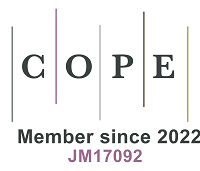REFERENCES
1. Birnbaum LS, Staskal DF. Brominated flame retardants: cause for concern? Environ Health Perspect 2004;112:9-17.
2. Covaci A, Harrad S, Abdallah MA, et al. Novel brominated flame retardants: a review of their analysis, environmental fate and behaviour. Environ Int 2011;37:532-56.
3. Convention S. All POPs listed in the Stockholm Convention. Available from: http://chm.pops.int/TheConvention/ThePOPs/AllPOPs/tabid/2509/Default.aspx [Last accessed on 8 Dec 2022].
4. Papachlimitzou A, Barber JL, Losada S, Bersuder P, Law RJ. A review of the analysis of novel brominated flame retardants. J Chromatogr A 2012;1219:15-28.
5. Xiong P, Yan X, Zhu Q, et al. A review of environmental occurrence, fate, and toxicity of novel brominated flame retardants. Environ Sci Technol 2019;53:13551-69.
6. Kuramochi H, Takigami H, Scheringer M, Sakai S. Estimation of physicochemical properties of 52 non-PBDE brominated flame retardants and evaluation of their overall persistence and long-range transport potential. Sci Total Environ 2014;491-492:108-17.
7. Wang Y, Zhang Y, Tan F, et al. Characteristics of halogenated flame retardants in the atmosphere of Dalian, China. Atmospheric Environ 2020;223:117219.
8. Wang L, Deng J, Yang L, Yu T, Yao Y, Xu D. Dynamic analysis of particulate pollution in haze in Harbin city, Northeast China. Open Geosciences 2021;13:1656-67.
9. Rajagopalan S, Al-Kindi SG, Brook RD. Air pollution and cardiovascular disease: JACC state-of-the-art review. J Am Coll Cardiol 2018;72:2054-70.
10. Gautam D, B. Bolia N. Air pollution: impact and interventions. Air Qual Atmos Health 2020;13:209-23.
11. Jerrett M. Air pollution as a risk for death from infectious respiratory disease. Am J Respir Crit Care Med 2022;205:1374-5.
12. Lao JY, Xie SY, Wu CC, Bao LJ, Tao S, Zeng EY. Importance of dermal absorption of polycyclic aromatic hydrocarbons derived from barbecue fumes. Environ Sci Technol 2018;52:8330-8.
13. Cao Z, Chen Q, Ren M, et al. Higher health risk resulted from dermal exposure to PCBs than HFRs and the influence of haze. Sci Total Environ 2019;689:223-31.
14. Fan Y, Chen Q, Wang Z, et al. Identifying dermal exposure as the dominant pathway of children’s exposure to flame retardants in kindergartens. Sci Total Environ 2022;808:152004.
15. Harner T, Bidleman TF. Octanol-air partition coefficient for describing particle/gas partitioning of aromatic compounds in urban air. Environ Sci Technol 1998;32:1494-502.
16. Yamasaki H, Kuwata K, Miyamoto H. Effects of ambient temperature on aspects of airborne polycyclic aromatic hydrocarbons. Environ Sci Technol 1982;16:189-94.
17. Meng Y, Zhang H, Qiu Y, et al. Seasonal distribution, gas-particle partitioning and inhalation exposure of brominated flame retardants (BFRs) in gas and particle phases. Environ Sci Eur 2019:31.
18. Wang D, Wang P, Zhu Y, et al. Seasonal variation and human exposure assessment of legacy and novel brominated flame retardants in PM2.5 in different microenvironments in Beijing, China. Ecotoxicol Environ Saf 2019;173:526-34.
19. Pal VK, Khwaja HA. Personal exposure and inhaled dose estimation of air pollutants during travel between Albany, NY and Boston, MA. Atmosphere 2022;13:445.
20. Li Y, Chen L, Ngoc DM, et al. Polybrominated diphenyl ethers (PBDEs) in PM2.5, PM10, TSP and gas phase in office environment in Shanghai, China: occurrence and human exposure. PLoS One 2015;10:e0119144.
21. Jin R, Liu G, Jiang X, et al. Profiles, sources and potential exposures of parent, chlorinated and brominated polycyclic aromatic hydrocarbons in haze associated atmosphere. Sci Total Environ 2017;593-594:390-8.
22. Li L, Arnot JA, Wania F. How are humans exposed to organic chemicals released to indoor air? Environ Sci Technol 2019;53:11276-84.
23. Cao Z, Zhao L, Zhang Y, et al. Influence of air pollution on inhalation and dermal exposure of human to organophosphate flame retardants: a case study during a prolonged haze episode. Environ Sci Technol 2019;53:3880-7.
24. Goede H, Christopher-de Vries Y, Kuijpers E, Fransman W. A review of workplace risk management measures for nanomaterials to mitigate inhalation and dermal exposure. Ann Work Expo Health 2018;62:907-22.
25. Andersen C, Krais AM, Eriksson AC, et al. Inhalation and dermal uptake of particle and gas-phase phthalates-a human exposure study. Environ Sci Technol 2018;52:12792-800.
26. Silva EZM, Dorta DJ, de Oliveira DP, Leme DM. A review of the success and challenges in characterizing human dermal exposure to flame retardants. Arch Toxicol 2021;95:3459-73.
27. Weschler CJ, Nazaroff WW. Dermal uptake of organic vapors commonly found in indoor air. Environ Sci Technol 2014;48:1230-7.
28. Weschler CJ, Bekö G, Koch HM, et al. Transdermal uptake of diethyl phthalate and Di(n-butyl) phthalate directly from air: experimental verification(. EHP ;123:928-34.
29. Zhu G, Wang Q, Tang Q, Gu R, Yuan C, Huang Y. Efficient and scalable functional dependency discovery on distributed data-parallel platforms. IEEE Trans Parallel Distrib Syst 2019;30:2663-76.
30. Luo Y, Liu S, Che L, Yu Y. Analysis of temporal spatial distribution characteristics of PM(2.5) pollution and the influential meteorological factors using Big Data in Harbin, China. J Air Waste Manag Assoc 2021;71:964-73.
31. Hu PT, Ma WL, Zhang ZF, et al. Approach to predicting the size-dependent inhalation intake of particulate novel brominated flame retardants. Environ Sci Technol 2021;55:15236-45.
32. Li YF, Qiao LN, Ren NQ, Sverko E, Mackay D, Macdonald RW. Decabrominated diphenyl ethers (BDE-209) in Chinese and global air: levels, gas/particle partitioning, and long-range transport: is long-range transport of BDE-209 really governed by the movement of particles? Environ Sci Technol 2017;51:1035-42.
33. Xu H, Du S, Cui Z, Zhang H, Fan G, Yin Y. Size distribution and seasonal variations of particle-associated organochlorine pesticides in Jinan, China. J Environ Monit 2011;13:2605-11.
34. Yadav IC, Devi NL, Zhong G, Li J, Zhang G, Covaci A. Occurrence and fate of organophosphate ester flame retardants and plasticizers in indoor air and dust of Nepal: implication for human exposure. Environ Pollut 2017;229:668-78.
35. Weschler CJ, Nazaroff WW. SVOC exposure indoors: fresh look at dermal pathways. Indoor Air 2012;22:356-77.
36. China Environment Publishing Group. Ministry of Ecology and Environment. Exposure factors handbook of chinese population, 2013. Available from: https://www.researchgate.net/publication/294646021_zhongguorenqunbaolucanshushouce_Exposure_Factors_Handbook_of_Chinese_Population [Last accessed on 8 Dec 2022].







